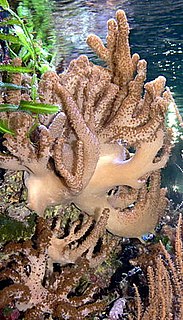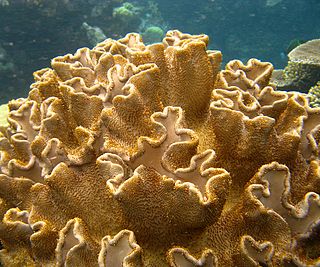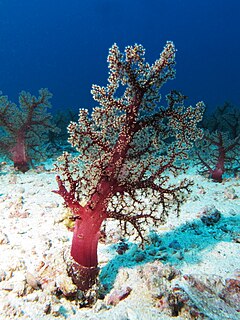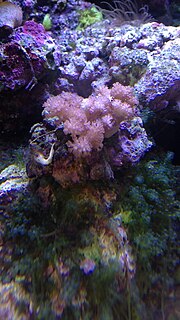
Xenia is a genus of photosynthetic soft marine coral in the family Xeniidae. They resemble a mushroom, with "arms" coming out from the top that end in many-fingered "hands". It is unique among corals because of its ability to use its "hands" to "pulse" or push water away from the colony in a constant, grabbing motion. Common names include fast-pulse Xenia. Species of Xenia are sometimes referred to as pulse corals.

Alcyonacea, or soft corals, are an order of corals. In addition to the fleshy soft corals, the order Alcyonacea now contains all species previously known as "gorgonian corals", that produce a more or less hard skeleton, though quite different from "true" corals (Scleractinia). These can be found in suborders Holaxonia, Scleraxonia, and Stolonifera. They are sessile colonial cnidarians that are found throughout the oceans of the world, especially in the deep sea, polar waters, tropics and subtropics. Common names for subsets of this order are sea fans and sea whips; others are similar to the sea pens of related order Pennatulacea. Individual tiny polyps form colonies that are normally erect, flattened, branching, and reminiscent of a fan. Others may be whiplike, bushy, or even encrusting. A colony can be several feet high and across, but only a few inches thick. They may be brightly coloured, often purple, red, or yellow. Photosynthetic gorgonians can be successfully kept in captive aquaria.

Alcyoniidae is a family of leathery or soft corals in the phylum Cnidaria.

Nephtheidae is a family of soft corals in the phylum Cnidaria. Members of this family are known as carnation corals, tree corals or colt soft corals. They are very attractive and show a wide range of rich and pastel colours including reds, pinks, yellows and purples. They are popular with reef aquarium hobbyists.

Melithaea is a genus of octocorals in the family Melithaeidae. Members of the genus are commonly known as fan corals and are found in the tropical Indo-Pacific region. The type species is Melithaea ochracea.

Dendronephthya is a genus of soft corals in the family Nephtheidae. There are over 250 described species in this genus. They are sometimes kept in aquariums, but are notoriously difficult to keep, requiring a near constant supply of small foods such as phytoplankton.

Alcyonium is a genus of soft corals in the family Alcyoniidae.

Sinularia is a genus of soft coral in the family Alcyoniidae. They are commonly known as leather corals and currently have 166 described species in the genus.

Virgularia is a genus of sea pen in the family Virgulariidae.

Siphonogorgia is a genus of soft corals in the family Nidaliidae. Like other members of this family, these corals do not contain symbiotic zooxanthellae.

Anthomastus is a genus of soft corals in the family Alcyoniidae.

Clavulariidae is a family of soft corals in the suborder Stolonifera. Colonies in this family consist of separate retractable polyps growing from a horizontal, encrusting stolon or basal membrane. The tissues are stiffened by sclerites.

Klyxum is a genus of animals in the family Alcyoniidae. They are commonly called cauliflower colt coral, or simply colt coral. These common names can also refer to the related genus Cladiella.

Anthelia is a genus of soft corals in the family Xeniidae.

Litophyton is a genus of soft corals in the family Nephtheidae.

Chrysogorgia is a genus of soft corals in the family Chrysogorgiidae.
Parasphaerasclera is a genus of soft coral. It is the only genus in the monotypic family Parasphaerascleridae.

Sarcophyton is a genus of corals in the family Alcyoniidae that are commonly kept in reef aquaria.
Villagorgia is a genus of gorgonian-type octocorals in the family Plexauridae.

















